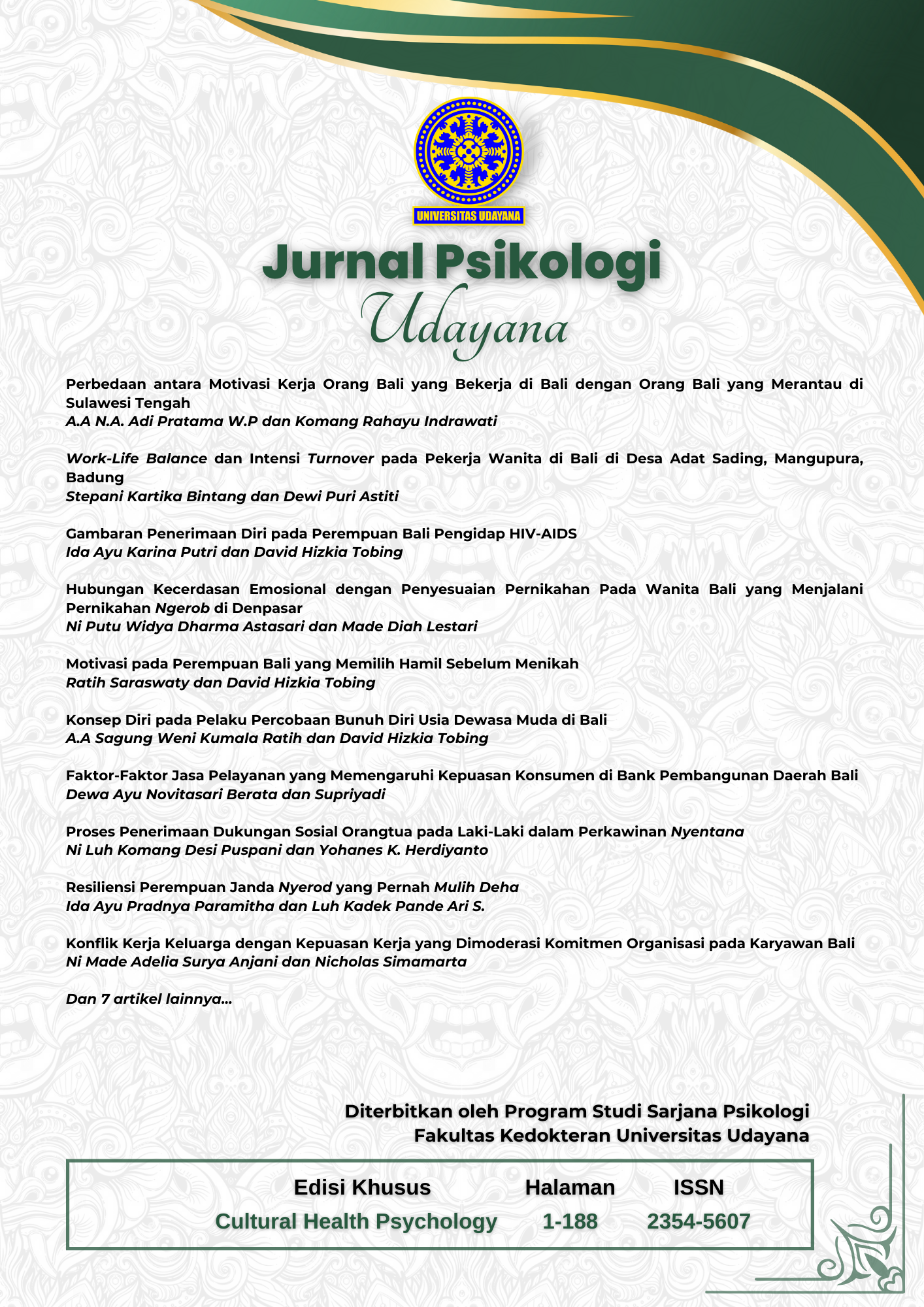KONSEP DIRI PADA PELAKU PERCOBAAN BUNUH DIRI PRIA USIA DEWASA MUDA DI BALI
Abstract
In these past years, the phenomenon’s of suicide case are becomes worrying. Indonesia, as one of a country who has a collective culture has a quite high number of suicide case. WHO estimates that by year 2020 the number of suicide case in Indonesia will be increased up to 2.4 percent from 100.000 people, if the government and the society don’t take it as serious things to concern (Mardani, 2012). Bali province as one of the province in Indonesia has a high rate in case of suicide, besides the Special Region of Yogyakarta (Hawari, 2010). Suicide cases in Bali are majority done by man, young adult people (Lesmana, 2008). Suicide and the attempted suicide are one of the ways or act to hurt or harm themselves, which arise as one of the effect of an intrapsychic conflict within themselves. One of the factors that is influence the occurring of a behavior including the suicide behavior and the attempted suicide are the self-concept. The self-concept is a way of someone to see themselves, the perception about the social environment (the other people), and also the perception about the way people think and see about themselves. This phenomenon becomes an interesting thing by the researcher to know what self-concept that is owned by the man young adult person suicide attempters in Bali.
This study use qualitative method and phenomenological approach, with 5 (five) man young adult suicide attempters in Bali. This study shows that there are 5 (five) component of self-concept that is occurs in the man young adult in Bali, however this component self-concept are not totally positive. Eventhough there are self-components that is shows the positive things of a self-acceptance and self-evaluation, but, almost of this shows the negative side of the self-concept characteristic, especially the social self component and the personal self component that is owned by the respondents. Some factors that is influence the self-concept of the man young adult suicide attempters in Bali are, the education, the economic, genetic, social learning, and culture.
Keywords : Self-Concept, Attempted Suicide, Young Adult, Bali
Downloads
References
Alsa, A. (2004). Pendekatan Kuantitatif & Kualitatif Serta Kombinasinya Dalam Penelitian Psikologi. Yogyakarta: Pustaka Pelajar.
Amarullah, A. (2009, Desember 02). Kasus Bunuh Diri di Indonesia. Dipetik April 03, 2013, dari Viva News: http://nasional.news.viva.co.id/news/read/110420-kasus_bunuh_diri_di_indonesia
Anastasiu, I. (2011). Family and School Understood As Agent of Socialization. Journal Euromentor , http://euromentor.ucdc.ro/2011/en/familyandschoolunerstoodasagentofsocializationionutanastasiu_2.pdf.
Atwater, E. (1983). Psychology of Adjustment Second Edition. United States of America: Prentice-Hall. Inc.
Bali Post. (2008, November 17). Hambatan Budaya Patriarki. Dipetik April 20, 2013, dari Bali Post: http://www.balipost.co.id/mediadetail.php?module=detailopiniindex&kid=3&id=988
Brigham. (1991). Social Psychology (2nd edition). New York: Harper Collins Publisher.
Burns, R. (1993). Konsep Diri (Teori, Pengukuran, Perkembangan, dan Perilaku). Jakarta: Arcan.
Chang, L., Chang, C. M., & Stew, S. M. (2003). Life Satisfaction, Self-Concept, and Family Relations in Chinese Adolescents and Children. International Journal of Behavioral Development (http://jbd.sagepub.com/) , 182.
Christie, D. J., Wagner, R. V., & Winter, D. A. (2001). Peace, Conflict, and Violence : Peace Psychology for the 21st Century. Englewood Cliffs, New Jersey: Prentice-Hall.
Corr, C., Nabe, C., & Corr, D. (2003). Death and Dying Life and Living 4th Edition. Belmont, CA: Wadsworth, Thomson Learning Publishing Co.
Diniari, N. K., & Hanati, N. (2012). Kesurupan, Tinjauan dari sudut budaya dan psikiatri. Jurnal Ilmiah Kedokteran (Medicina) , Volume 43 nomor 1.
Fitts, W. H. (1965). Manual for The Tennesse Self Concept Scale. Nashville: Counselor Recordings and Tests.
Hadisuprapto, P. (2011). Teori Kriminologi. Malang: Selaras.
Haryanto. (2010, Januari 15). Peranan Konsep Diri Dalam Menentukan Perilaku. Dipetik Oktober 28, 2013, dari Belajarpsikologi.com: http://belajarpsikologi.com/peranan-konsep-diri-dalam-menentukan-perilaku/
Hawari, H. D. (2010). Psikopatologi Bunuh Diri. Jakarta: Balai Penerbit FKUI.
Henderson, C. E., Dakof, G. A., Schwartz, S. J., & Liddle, H. A. (2006). Family Functioning, Self-Concept, and Severity of Adolescent Externalizing Problems. Springer Science+Business Media, Inc , 721–731.
Hurlock, E. B. (1992). Perkembangan Anak Jilid 2. Jakarta: Erlangga.
Hurlock, E. B. (1980). Psikologi Perkembangan. Jakarta: Erlangga.
Lesmana, J. (2008, November 06). Di Bali Setiap Dua Hari Seorang Bunuh Diri. Dipetik Oktober 19, 2013, dari Suryani Institute : http://www.suryani-institute.com/page/2/?s=bunuh+diri
Maramis, W. F. (2005). Catatan Ilmu Kedokteran Jiwa. Surabaya: Airlangga University Press.
Mardani. (2012, Juni 02). Kasus Bunuh Diri di Indonesia Sudah Memprihatinkan. Dipetik April 03, 2013, dari Merdeka.com: http://www.merdeka.com/tag/b/bunuh-diri/kasus-bunuh-diri-di-indonesia-sudah-memprihatinkan/
Moleong, L. J. (2004). Metodologi Penelitian Kualitatif. Bandung: PT Remaja Rosdakarya.
Muhadjir, N. (2002). Metodologi Penelitian Kualitatif. Yogyakarta: Rake Sarasin.
Neiss, M. B., Sedikides, C., & Stevenson, J. (2002). Self-Esteem: A Behavioural Genetic Perspective. European Journal of Personality , 351–367 .
Papalia, D. E., Olds, S. W., & Feldman, R. D. (2009). Human Development Eleventh Edition. United State of America: Mc Graw Hill.
Pos Bali. (2014, November 06). Kumpulan Berita Bunuh Diri. Dipetik November 06, 2014, dari Pos Bali: http://posbali.com/page/1/?s=bunuh+diri
Pos Bali. (2014, November 18). Kumpulan Berita Gantung Diri. Dipetik November 18, 2014, dari Pos Bali: http://www.posbali.com/page/1-3/?s=gantung+diri
Rubrik, R. (2014, September 05). Satu Orang Bunuh Diri Setiap 40 Detik. Dipetik September 2014, 2014, dari DW: http://www.dw.de/satu-orang-bunuh-diri-setiap-40-detik/a-17903619
Satuharapan. (2014, September 11). Kasus Percobaan Bunuh Diri Mencapai 800.000 Per Tahun. Dipetik September 11, 2014, dari Satu Harapan.com: http://www.satuharapan.com/read-detail/read/kasus-percobaan-bunuh-diri-mencapai-800000-per-tahun
Scarpa, S. (2011). Physical Self-Concept and Self-Esteem in Adolescent and Young Adulthood With and Without Physical Disability. European Journal of Adapted Physical Activity , 38-53.
Sianturi, M. N. (2007). Konsep Diri Remaja yang Pernah Mengalami Kekerasan dalam Rumah Tangga (KDRT). Jurnal Fakultas Psikologi Universitas Diponegoro Semarang .
Subrata, M. (2011, Februari 27). Bunuh Diri dan Masalah Kesehatan Masyarakat. Dipetik April 15, 2013, dari Balipost Online: http://www.balipost.co.id/mediadetail.php?module=detailberitaminggu&kid=15&id=48706
Sudhita, I. W. (2010). Perilaku Bunuh Diri di Kalangan Pelajar (Analisis Deskriptif Pemberitaan Bali Post Tahun 2006 – 2009). ISSN 1829-5282 , 25-40.
Sugiyono. (2013). Metode Penelitian Kuantitatif Kualitatif Dan R&D. Bandung: Alfabeta.
Sulaeman, D. (1995). Psikologi Remaja : Dimensi - Dimensi Perkembangan. Bandung: Mandar Maju.
Supyanti, W. E., & Wahyuni, A. S. (2012). Pencegahan Bunuh Diri Pada Anak dan Remaja Dengan Gangguan Depresi. Bagian/SMF Ilmu Kedokteran Jiwa FK Unud/RSUP Sanglah Denpasar
Teoh, H. J., & Afiqah, N. (2010). Self Esteem Amongst Young Adults: The Effect of Gender. MJP Online Early .
Widjaya, I. (2011, Mei 12). Survei : Gangguan Jiwa Picu Bunuh Diri di Bali. Dipetik Oktober 19, 2013, dari Viva News : http://nasional.news.viva.co.id/news/read/220071-survei--gangguan-jiwa-picu-bunuh-diri-di-bali
Widnya, I. K. (2010). Bunuh Diri di Bali : Perspektif Budaya dan Lingkungan Hidup. Jurnal Institut Hindu Dharma Negeri .
Wink, P., & Dillon, M. (2002). Spiritual Development Across the Adult Life Course: Findings From a Longitudinal Study. Journal of Adult Development, , Vol. 9, No. 1.
Wirawan, H. E. (2010). Kebahagiaan Menurut Dewasa Muda Indonesia. Jurnal Universitas Tarumanegara Jakarta .
Zai, C. C., Luca, V. d., Strauss, J., Tong, R. P., Sakinofsky, I., & Kennedy, J. L. (2012). Genetic Factors and Suicidal Behavior. Dalam Y. Dwivedi, The Neurobiological Basis of Suicide (hal. Chapter 11). Boca Raton (FL): CRC Press.
Authors who publish with this journal agree to the following terms:
- Authors retain copyright and grant the journal right of first publication with the work simultaneously licensed under a Creative Commons Attribution-ShareAlike 4.0 International License that allows others to share the work with an acknowledgement of the works authorship and initial publication in this journal.
- Authors are able to enter into separate, additional contractual arrangements for the non-exclusive distribution of the journals published version of the work (e.g., post it to an institutional repository or publish it in a book), with an acknowledgement of its initial publication in this journal.
- Authors are permitted and encouraged to post their work online (e.g., in institutional repositories or on their website) prior to and during the submission process, as it can lead to productive exchanges, as well as earlier and greater citation of published work (See The Effect of Open Access).













